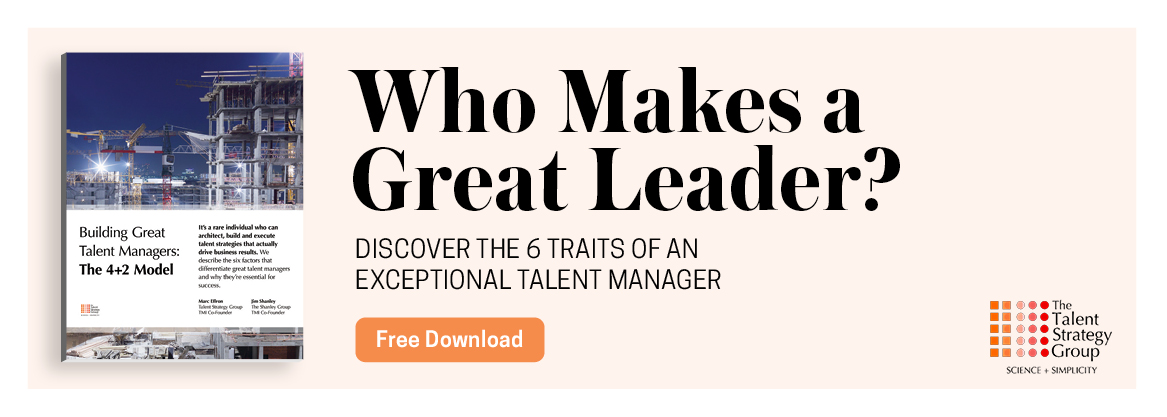When business leaders and HR professionals understand the why, what, and how of organizational culture, they deliver more value.
By Wayne Brockbank and Dave Ulrich
“Culture” is a loaded word. It can refer to the performing arts (humanistic culture), a group of ideas (consumer culture), an issue (culture of transparency), or something specific (marching band culture).
But the concept of culture has an increasing resurgence and relevance for organizations. When business leaders and HR professionals master the why, what, and how of organizational culture, they deliver more value.
Sign up for the monthly TalentQ Newsletter, an essential roundup of news and insights that will help you make critical talent decisions.
Why Culture Matters
Culture is central for business success and is becoming an HR priority. It’s top of mind for CEOs who want to adapt their organization, future high potential employees who are looking for a cultural fit, and even for Chartered Institute of Auditors who have prepared recent documentation to help auditors monitor culture.
As organizational users, we continually encounter culture. When we shop, eat at a restaurant, stay in a hotel, fly on an airplane, or even visit friends, we experience an organization’s culture that affects how people think, behave, and feel about their organization and how employees feel about working at the organization. We also experience if employees are focused on themselves, their bosses or on their customers.
One of the authors had the unique opportunity to interview the senior HR executives from 15 globally recognized firms in the financial, defense, and high-tech sectors. Most of their companies were the highest performers in their sectors. Each interview lasted 2 to 3 hours.
The focal question of the interview was: “What 2 to 3 HR practices or agendas create the greatest performance differentiation between your company and your competitors?” The overwhelmingly most frequently mentioned agenda by the highest performing companies was the seamless integration of the following:
- Connecting HR to a clearly defined short list of business imperatives.
- Focusing on culture as the basic integrating framework for all HR practices and as the primary mechanism through which HR practices are linked to business requirements.
- Leveraging all talent tools to sustain the culture agenda while also ensuring their role in hiring, developing and retaining the best individual talent.
These findings are supported by empirical research. Deloitte found that culture and engagement were rated as the most important human capital issue, edging out leadership which had been the most highly rated in previous years.
An important article in Group and Organization Management showed that CEOs’ personalities have significant influence on business performance primarily through their influence on culture, which in turn has influence on business performance. Finally, in the International Journal of Organizational Leadership, researchers found that leadership has a strong influence on employee commitment, but only through the mechanism of organizational culture.
This recent resurgence of culture is undoubtedly the result of three conditions.
First, in the midst of economic turbulence, high-performing companies effectively respond through the fundamental cultural values on which they are built.
Second, with mergers and acquisitions again increasing, the shelf life of technical knowhow plummeting, and individual talent being increasingly uniform (at least, among major competitors), culture becomes the key mechanism through which to successfully integrate merged companies, to develop and leverage technical knowhow and to integrate individual talent so that the organization whole is greater than the sum of the parts.
Finally, the resurgence of culture is also a result of HR departments being more sophisticated and rigorous in designing, creating and leveraging business cultures.
HR executives in the high performing firms are highly skilled in understanding the nuances of market-based business priorities and their cultural implications. They’re considerably more exacting in defining specific cultural behaviors that drive business performance.
The movement away from generic behavior or competency-based models is noticeable. They’re much more disciplined in aligning the full range of talent management tools with critical cultural attributes.
What Culture Means
One of the challenges of managing culture is that it has become a Rorschach test for those interested in organizations; there are related concepts, terms, and prescriptions that require clarity. Are organization cultures to be thought of as resources, core competencies, health, climate, processes, values, shared mind-sets, organization types, or systems?
With these confusing concepts, no wonder business leaders and HR professionals have difficulty in creating competitive organizations.
We talked to a CHRO who said her CEO was very committed to fundamental business transformation, but many of the terms related to “culture” were fuzzy to him. The concept of culture clearly matters, but it’s difficult to articulate or define with any unified precision.
We propose a three-stage evolution for clarifying what culture means:
- Phase 1 is culture as seen through symbols, rituals, stories, and other organization events. We experience or see these cultural artefacts when we observe or join an organization.
- Phase 2 is culture as seen through how it’s a reflection of how people think, behave, and feel in the organization. Culture shows up in the values, norms, unwritten rules, emotional responses to, or flows of how things are done in a company. Most of the above current definitions follow this dominant culture logic.
- Phase 3 shifts understanding of culture by clarifying culture from the outside in. In this phase, culture is the identity of a company in the mind of the best customers, made real to all employees throughout a company.
Each of these phases of cultural definition affect the focus and behaviors of employees. In Phase 1 (symbols), employee affect comes from the organizational events. In Phase 2 (values, beliefs), employee engagement comes from enacting the organization’s values. In Phase 3 (outside in), employees’ behaviors and thoughts are focused on the right things, those that matter to customers.
By moving to the outside-in, customer-centric view of culture, we create clarity about a winning culture. The words that are used to describe culture represent categories of behaviors as they are experienced and perceived by customers and investors.
Thus, Southwest Airlines wants to be known for low price with a fun experience; Marriott for exceptional service; Apple for design and simplicity; Google for innovation.
These firm brands or identities should then become infused through the company as employees think and behave in concert with these culture aspirations. Culture is less obtuse and more focused, and it’s not a social, but business agenda.
How to Change Culture
Organizational culture isn’t static; it changes and should change as customer expectations change. Disney’s adoption of technology enables guests to have a better experience in their Disney stay. Yum Foods (KFC, Taco Bell, Pizza Hut) has shifted to more healthy food as consumer tastes have changed. Business leaders and HR professionals should become the architects of culture change by engaging in five steps:
Step #1: Define the desired culture.
As we stated, culture isn’t just the institutionalization of personal values, but the values that create value as experienced by external stakeholders. When a firm’s market brand becomes the guiding light for the culture, culture is both a social and business agenda. HR professionals can work with marketing colleagues to turn firm brand into organizational culture.
Step #2: Make the culture real to customers.
A firm’s culture should be transparent to customers. HR professionals can ask customers how the thoughts and behaviors of their firm’s employees can add greater value to customers. This means asking customers what service, innovation, efficiency or collaboration means to the customer, then turning these customer expectations into employee actions.
Step #3: Make the culture real to employees.
Ultimately, an organization’s culture shows up in how employees think (head), do (hands and feet), and feel (heart and soul). HR professionals can communicate clear and simple cultural messages. The high-level statement of cultural aspiration should then be translated into specific concepts that shape ideas, specific behaviors that enable employees to act on these ideas, and specific values that help employees find meaning from the cultural messages.
Step #4: Institutionalize culture through HR practices.
HR practices are the most powerful tools to institutionalize culture. People can be hired, trained, promoted, and outplaced consistent with culture. Performance management and rewards can align with and reinforce culture. Information systems reinforce culture through all communication mechanisms including mechanisms that bring important external information into the firm and that facilitate important information throughout the firm.
Organization design choices reinforce culture through reporting relationships, work design, and corporate policy. As these HR practice areas encourage culture in a disciplined and integrated manner, the culture becomes part of the fabric of the organization.

Step #5: Help business leaders model culture.
Leaders can model culture by where they spend time, what questions they ask, which people they meet with, what decisions they make, how they interact with others, and how they allocate budget and time. We’ve coined the term leadership brand to capture how leaders model customer expectations.
Business leaders own and HR professionals architect the right culture by making sure that HR practices align and reinforce the desired culture.
For the last 20 years, HR has been consumed with winning the “war for talent.” We now find that as HR organizations have moved up to 70 to 80 percent of the S-curve on fighting the war for talent, they know what to do and how to improve talent.
When HR professionals master the why, what, and how of organization culture, they create competitive advantage and ensure victory through organization.
Wayne Brockbank is the first partner emeritus of The RBL Group, a consulting firm focused on helping organizations and leaders deliver value. Brockbank has made significant contributions as a Clinical Professor of Business at the Ross School of Business at the University of Michigan, and as a consultant and executive educator at The RBL Group.
Dave Ulrich is the Rensis Likert Professor at the Ross School of Business, University of Michigan and a partner at The RBL Group. He studies how organizations build capabilities of leadership, speed, learning, accountability, and talent through leveraging human resources. He has helped generate award-winning databases that assess alignment between strategies, organization capabilities, HR practices, HR competencies, and customer and investor results.


